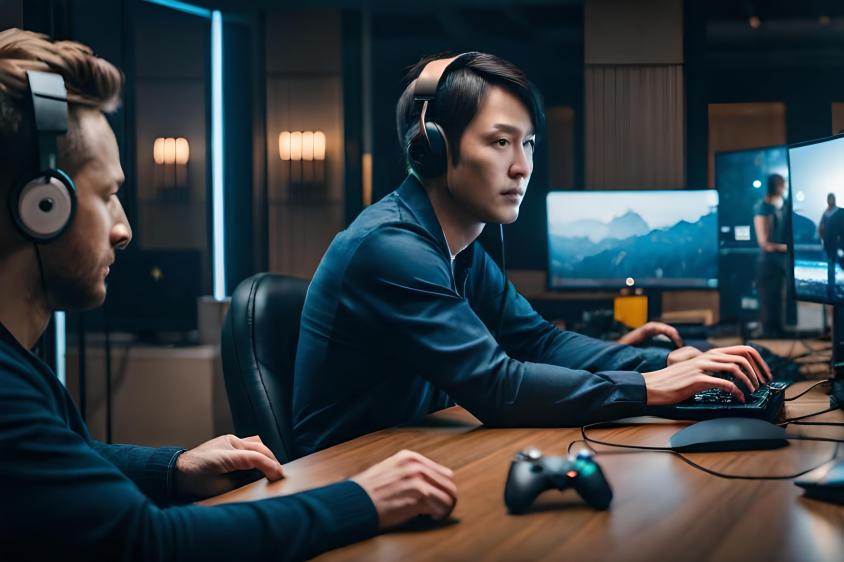Explanation of jitter clicking
Jitter clicking is a technique that requires you to rapidly tap the mouse button with your index finger while keeping the other fingers firmly pressed on the mouse. This technique is often used by gamers who want to increase their clicking consistency and improve their gaming performance. However, it's important to note that jitter clicking can cause finger strain and decrease hand endurance over time.
The speed at which you click the mouse button through jitter clicking can also affect your mouse sensitivity. This is because the rapid tapping can create small movements in your hand, which can affect the accuracy of your mouse movements. Therefore, it's important to find the right balance between clicking speed and mouse sensitivity to achieve the best results.
While jitter clicking can be an effective technique for gamers, it's important to use it in moderation and take breaks to avoid any potential strain or injury to your fingers.
Explanation of butterfly clicking
When using the butterfly clicking technique, gamers can achieve even faster clicking speeds by alternating between two fingers. This method involves using the index and middle fingers to rapidly tap the mouse button, creating a fluttering motion that resembles the flapping of butterfly wings.
This technique requires a different mouse grip than jitter clicking, with the hand positioned in a way that allows for quick and precise finger movements. The speed and frequency of butterfly clicking can vary depending on the individual's skill level and hand fatigue.
Some gamers are able to achieve clicking speeds of over 20 clicks per second, but this can lead to increased hand fatigue and discomfort over time. It's important for gamers to find a comfortable and sustainable clicking speed that doesn't cause strain or injury to their hands.
When it comes to optimizing your butterfly clicking technique, having the right mouse can make a significant difference in your performance and overall gaming experience.
If you're looking for the best mouse for butterfly clicking, be sure to check out our article on mouse for butterfly clicking. We provide in-depth reviews and recommendations of mice that are specifically designed to enhance your butterfly clicking performance. Choosing the right mouse can improve your accuracy, comfort, and clicking speed, allowing you to take your gaming to the next level.
Therefore, we highly recommend exploring our guide on the best mouse for butterfly clicking to find the perfect mouse that suits your needs and elevates your butterfly clicking skills.
Key Differences
When it comes to comparing the clicking techniques of jitter click and butterfly click, there are some key differences to keep in mind.
First, clicking speed can vary significantly between the two techniques, with jitter click generally being faster.
However, butterfly click offers more control and precision, allowing for more accurate clicking in games and other applications.
It's important to understand these differences in order to choose the clicking technique that best suits your needs.
To learn more about the comparison between drag click and butterfly click, you can check out our article on Drag Click Vs Butterfly Click for a detailed analysis of these two techniques and their pros and cons.
Clicking Technique
You'll want to master your clicking technique if you want to dominate in competitive gaming and leave your opponents in awe. Whether you're using jitter clicking or butterfly clicking, it's crucial to maintain a steady clicking force to avoid finger strain and ensure consistent gaming performance.
With both techniques, muscle memory plays a significant role in achieving the desired results. Jitter clicking involves rapidly tapping your fingers on the mouse button, while butterfly clicking alternates between two fingers.
To effectively execute jitter clicking, you need to develop your hand dexterity to maintain a high clicking rate without compromising accuracy. This technique is known for producing an extremely high clicking rate, which is essential in games that require quick reflexes. However, it's important to note that jitter clicking can cause muscle fatigue and strain, which can lead to a decline in gaming performance over time.
On the other hand, butterfly clicking is less straining on your fingers, but it requires more precision and coordination between your two fingers. With practice, you can develop the muscle memory needed to execute this technique smoothly and accurately, improving your gaming performance in games that require a more controlled clicking rate.
Clicking Speed
If you want to achieve a high CPS, it's essential to focus on increasing your clicking speed. However, it's important to note that clicking speed isn't everything.
You need to balance your speed with precision and accuracy to improve your gaming performance. One way to increase your clicking speed is by practicing jitter clicking or butterfly clicking techniques.
Jitter clicking involves rapidly contracting your finger muscles to click the mouse button as fast as possible. This technique can lead to a higher CPS but may result in finger strain and fatigue.
On the other hand, butterfly clicking involves using two fingers to click the mouse button alternately, which can lead to higher CPS without causing as much finger strain. However, the effectiveness of these techniques also depends on your mouse sensitivity, finger dexterity, and ability to perform practice drills consistently.
Ultimately, finding the right balance between speed and accuracy is key to improving your gaming performance.
Control and Precision
To really up your game, it's important to master your control and precision when clicking the mouse. While both jitter clicking and butterfly clicking can achieve high clicking speeds, the difference lies in the level of control each technique offers.
Jitter clicking involves rapidly tapping the mouse button with your finger, which can lead to a lack of precision and accuracy. On the other hand, butterfly clicking allows for a more controlled clicking speed by using two fingers in a flapping motion. This technique is less physically taxing and can lead to a more consistent clicking rhythm.
When it comes to finger placement and hand positioning, butterfly clicking requires a different technique than jitter clicking. To butterfly click, you need to position your hand in a way that allows your index and middle fingers to flap up and down on the mouse buttons. This may take some practice to get used to, but once mastered, it can lead to better control and precision.
Additionally, training exercises can help improve your control and reduce muscle fatigue. These exercises can include finger stretches and hand exercises to increase dexterity and strength. Ultimately, the choice between jitter clicking and butterfly clicking depends on personal preference and the type of game being played, but mastering your control and precision is essential for improving your overall gaming performance.
Benefits and Drawbacks
When it comes to clicking techniques, two popular ones are jitter clicking and butterfly clicking. Jitter clicking involves rapidly tapping a mouse button using a specific part of your hand, while butterfly clicking involves using two fingers to click the button in quick succession.
Both techniques have their benefits and drawbacks, and it's important to understand them before deciding which one to use. In this discussion, we'll explore the advantages and disadvantages of jitter-clicking and butterfly clicking in detail, so you can make an informed choice.
Jitter Clicking
You can feel your fingers vibrating rapidly as you master the art of jitter clicking. This technique involves rapidly tapping your mouse button with two fingers, creating a jittery motion that can produce a higher CPS and a consistent click rate.
With enough practice, you can achieve a competitive advantage over other players who rely on traditional clicking methods. However, jitter clicking comes with a few drawbacks. The rapid finger movement can cause finger fatigue and increase the risk of carpal tunnel syndrome.
It may also be difficult to aim with at first, especially if you're not used to the hand position and mouse sensitivity required for jitter clicking. Timing your clicks correctly is also crucial, as mistimed clicks can negatively affect your gameplay.
Overall, jitter clicking can be a useful skill to master, but it's important to be aware of its limitations and potential risks.
Butterfly Clicking
Butterfly clicking is a mouse clicking technique that involves rapidly alternating between two fingers on the mouse button, which allows for a higher clicking speed compared to regular clicking methods.
This technique involves using the index and middle fingers to rapidly click on the mouse button, resulting in a higher click rate than one would achieve with normal clicking. By doing this, you can achieve a consistent CPS rate that can be useful in gaming performance, as well as other activities that require fast clicking.
While butterfly clicking may be advantageous for gamers, it does come with some drawbacks. One of the primary concerns is finger strain, as this clicking technique requires a lot of hand dexterity and can put a lot of stress on the fingers.
Additionally, butterfly clicking can be harder to get used to initially, which may require some practice before you can comfortably use it. However, with proper training and practice, butterfly clicking can be an effective way to improve your gaming performance and achieve a higher clicking speed with your mouse.
Final Thoughts
If you're looking for high CPS, jitter clicking may be the way to go but keep in mind the potential health risks and lack of precision. Butterfly clicking, on the other hand, offers more control and endurance, making it suitable for longer gaming sessions. When it comes to choosing between the two, it ultimately comes down to user preference and the specific gaming application.
In terms of efficiency comparison, jitter clicking can achieve higher CPS, but at the cost of precision and potentially causing hand fatigue or injury. Butterfly clicking may not reach the same CPS levels, but it offers more control and can be sustained for longer periods of time without causing as much strain on the hand.
Ultimately, it's important for gamers to weigh the pros and cons of each technique and choose the one that best suits their individual needs and play style.




